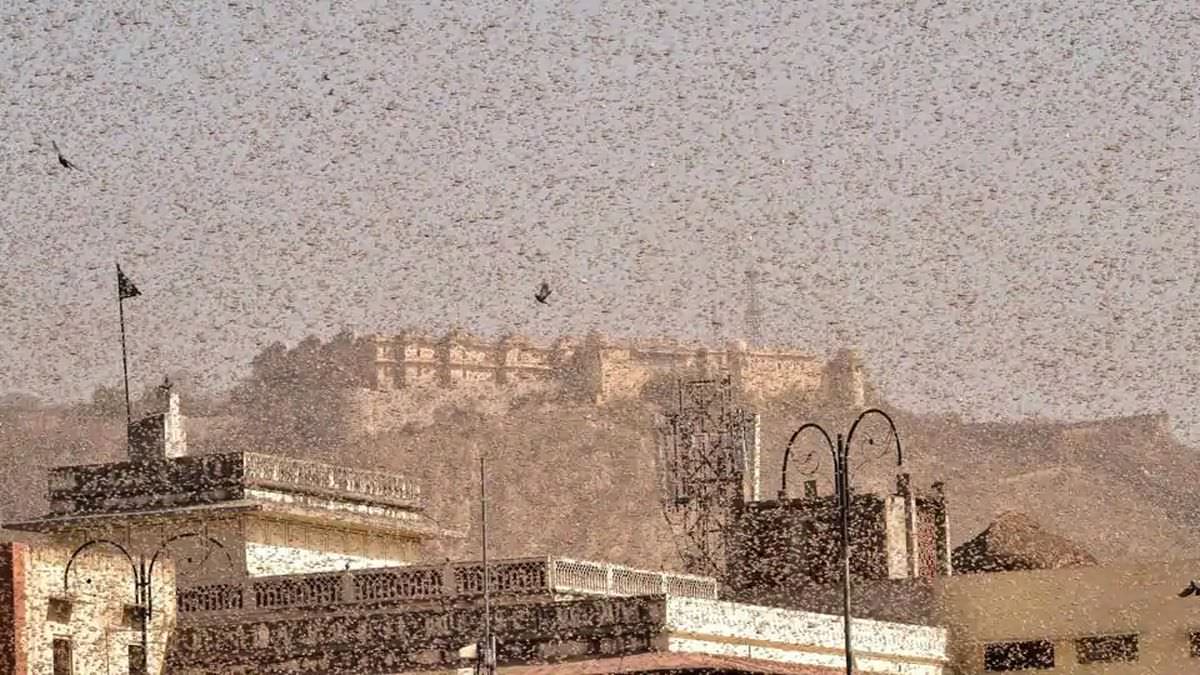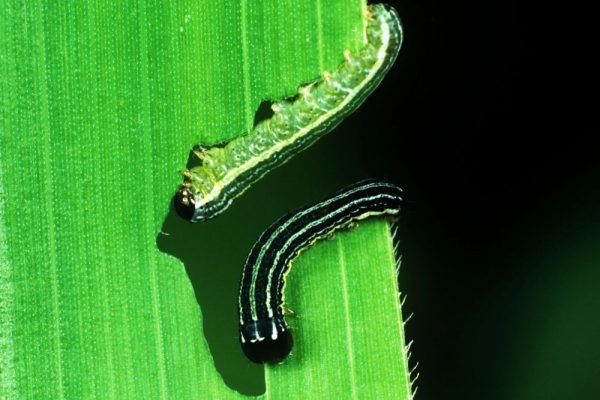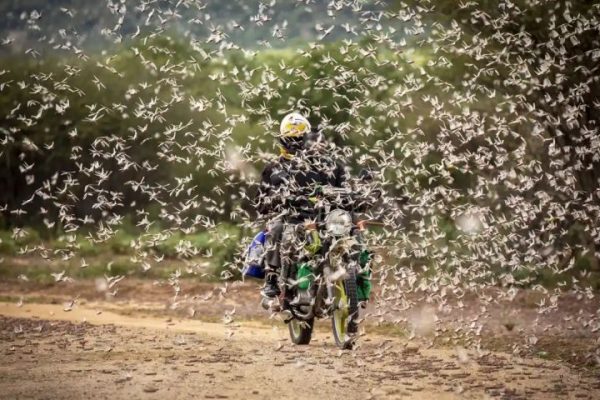Swarms of Locusts Wreaking Havoc in Several States of India
Indian does not seem to catch a break this year with the coronavirus pandemic, reoccurring earthquakes, a devastating cyclone and now the swarms of locusts wreaking havoc in several states of India. the pest is leaving destroyed crops and pastures in their wake which is worrying sign for the country.
The Union Environment Ministry had issued a warning in a statement last week that locust swarms have entered Rajasthan, Punjab, Haryana and Madhya Pradesh. There is an alert for national capital Delhi too.

Image: Hindustan Times
Farmers say that while the rabi crop has been harvested this year, locusts can still endanger the sprouting cotton crop, vegetables, and fodder that were sown last month.
We’re also worried about the damage they can cause to the tender millet and moong dal crops we’re preparing to sow now.
Says Ram Prasad, a farmer based in Jaisalmer, Rajasthan.
Earlier, it was predicted that huge swarms of these pests might be travelling to India via Africa, Middle East and Pakistan. Various sights have confirmed that locusts have in fact made their way through to the country to pester and feast on the crops.
Also Read: Locust Swarms Threaten Crops in African and South Asian Countries
First sightings have been reported from the state of Madhya Pradesh on May 24. A swarm of locusts was spotted on the outskirts of Jhansi district, while millions of them were seen on trees and in villages of Ujjain district. Afterwards, locusts started moving towards the city of Jaipur on May 25.
Reportedly, locusts had entered Rajasthan in April and have ravaged over 50,000 hectares of land so far.
District Magistrate Andra Vamsi said,
The villagers along with the common public has been told to inform control room about the movement. The locusts will go to the places where there is green grass or greenery. Hence, details about the movement at such places must be shared.
Deputy Director Agriculture Kamal Katiyar said that farmers had been made aware of the situation and the spraying of insecticides will be done at night. He further added,
The swarm of locusts, which is moving is small in size. We have got news that nearly 2.5 to 3-kilometre long swarm of locusts has entered the country. A team has come from Kota (Rajasthan) to tackle the locusts.
Swarms of locusts have been travelling through India from Rajasthan to Uttar Pradesh, destroying crops and pastures at a rapid pace. Presently, 16 out of 33 Rajasthan districts are affected by locust swarms.
Residents of Jaipur witnessed the frightening view of thousands of locusts resting on their terraces and swarming around and shared these sights on social media. Some called it an apocalypse-like situation, while others expressed their concerns for farmers and crops that will bear the brunt of this plague.
Locust attack in Jaipur…
That’s it, 2020 is the last year for humankind…!!! pic.twitter.com/JsQxRANsA6— Ridhi (@Not_A_Sister) May 25, 2020
Locust swarms in Jaipur this morning. #MondayMorning pic.twitter.com/g5PpCQtb7k
— Rakesh Goswami (@DrRakeshGoswami) May 25, 2020
Locust Ataack in Jaipur ? pic.twitter.com/QWHfOXasvf
— Akanksha? (@art_lover_09) May 25, 2020
Locust swarm spotted over the walled city and other parts of Jaipur.
Brace yourself for the tiddi dal.
My heart goes out to the farmers 🙁
Video via WA pic.twitter.com/A1JpeKyBiE
— RJ Purkhaa (@RJ_Purkhaa) May 25, 2020
Locust attack in Jaipur.
God know what more is left this year pic.twitter.com/NRhEa55jJ4
— #PrayForPoorsOfWB (@iHRumii_B) May 25, 2020
Locust swarms …#Jaipur
Is it time for Kaalki Avtar now? Or should we start building our own gigantic boats. #locust #swarms pic.twitter.com/bbMVUAndzf
— Manik (@Manik0226) May 25, 2020
Locust attack in jaipur..??
Very soon it will move towards other part of India..??
this year going to be worst for many reasons.. locusts can destroy crops in very short span of time… ?? pic.twitter.com/4d4kBHt19k— Harshita Patel (@_harshu_2799) May 25, 2020
Meanwhile, the situation is likely to escalate with many locust swarms moving at a fast pace throughout the country.
Scientists believe that the higher frequency of cyclones originating in the Indian Ocean in 2019 for the increased incidents of locust attacks this year.
This is the second round of locust attack in India, the first one occurred during December-February. It has been the fourth consecutive day of attacks in various states of India in this cycle.
The desert locust is considered the most destructive migratory pest in the world and a single swarm covering 1 square kilometre can contain up to 80 million locusts.
The Food and Agriculture Organization of the United Nations (FAO) said in a press release that there was an increased risk along both sides of the India-Pakistan border.
Despite control operations, recent heavy rains have created ideal conditions for the pest’s reproduction in several countries. Young juveniles will become voracious adults in June just as farmers begin to harvest, compounding an already bleak food security situation.
Locust attacks in 12 countries, including Pakistan, Iran and ten nations in Africa, have destroyed crops over millions of hectares of land. Countries in Africa and West Asia have been fighting swarms of locusts since December last year. Sindh, Balochistan and Punjab in Pakistan have been severely affected by the attacks.
Update (May 27, 2020):
It is feared that the swarms of locusts that ravaged Jaipur a couple of days ago, could be travelling towards the national capital, if the wind is favourable.
Entomologists said that despite being an urban area, the impact of this infestation could be severe on Delhi as 22 per cent of its area is under green cover, which could provide foraging material to the locusts.
According to the officials, about 42,000 hectares (104,000 acres) of cotton, summer pulses and vegetable crops have been affected by locusts across six states, mainly in Rajasthan.
As many as 700 tractors, 75 fire engines and almost 50 other vehicles are engaged in spraying pesticides to kill the locusts, said Trilochan Mohapatra, director general of the state-run Indian Council of Agricultural Research in New Delhi. He also added that drones will also be employed.
In Rajasthan, four swarms had entered in Jaipur, of which a swarm of about 6 KM in length and 1 KM in breadth was destroyed, while three more swarms remain at large.
According to weather experts at Indian Meteorological Department, wind direction changes seasonally but with regular variations depending on daily weather changes and rain-bearing systems. The wind is currently south-westerly and could help the swarms in their movement.
Experts fear that swarms could expand by June, if more action to control the infestation and mitigate its damage is not taken.
Update (May 29, 2020):
Director of Agriculture Dr RK Koundal said that a high alert has been issued in Kangra, Una, Bilaspur and Solan districts after massive swarms of desert locust have been reported destroying crops in adjoining states and that may spread to Himachal Pradesh.
The official said that field functionaries have been alerted to keep the continuous and constant vigilance on locust activity and get ready to control any emergency situation.
The Directorate General of Civil Aviation (DGCA) issued an operation circular directing all airlines’ staff, including pilots, to maintain caution about locust swarms hitting aircraft on landing or take-off or when planes are parked at the airport.
The DGCA also asked the air traffic controllers to warn pilots of locust presence in the aerodrome if they are aware of it, and also asked pilots to keep an eye on it during flights.
While an alert has been issued in Delhi, the farmers are being asked to make as much of a racket as possible, using drums, tin containers, utensils and even hiring mobile disc jockeys, in an attempt to scare away locust swarms that are ravaging the country.
Update (June 1, 2020):
The authorities have warned that the ongoing locust invasion in parts of Rajasthan, Gujarat, Madhya Pradesh, Chhattisgarh, Maharashtra and Uttar Pradesh is a potential precursor to bigger and deadlier attacks, which will likely take place towards the end of June and July.
As the country faces the worst ever desert locust outbreak in three decades, a farm expert has said that the government is just focusing on chemical spray on the migratory pest, ignoring other natural methods for controlling the menace, which could prove of immense help.
While the swarm of desert locusts have entered neighbouring Chhattisgarh, the Jharkhand agriculture department has issued an alert across all 24 districts in the state and has set up state, district and block level task forces to deal with the plague.

